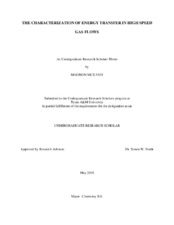| dc.creator | McIlvoy, Madison H | |
| dc.date.accessioned | 2018-05-23T15:32:33Z | |
| dc.date.available | 2018-05-23T15:32:33Z | |
| dc.date.created | 2018-05 | |
| dc.date.submitted | May 2018 | |
| dc.identifier.uri | https://hdl.handle.net/1969.1/166464 | |
| dc.description.abstract | Vibrationally Excited Nitric Oxide Monitoring (VENOM)14 is a technique which utilizes
the electronic excitation of the tracer molecule NO in high speed gas flows to make simultaneous
velocity and temperature measurements. The ability to model these flows using the Navier
Stokes turbulence equations is vital for the continued growth in both chemical and aerospace
fields. This technique increases the accuracy of the predictions made using these equations by
allowing both temperature and velocity measurements to be made using a single technique.
Presented here is the expansion of the technique to three component velocity using the invisible
ink method.13 The fluorescence lifetime is affected based on the composition of the flow. In
order to understand the effects of quantized energy being inserted into the flow, the quenching
behavior of benzene and C6F6 on the fluorescence lifetime was studied. Presented here is the use
of the near resonance energy transfer model as opposed to the harpoon model for predicting
collisional quenching cross sections | en |
| dc.format.mimetype | application/pdf | |
| dc.subject | energy transfer, Laser induced fluorescence, nitric oxide, VENOM, quenching, collisions | en |
| dc.title | The Characterization of Energy Transfer in High Speed Gas Flows | en |
| dc.type | Thesis | en |
| thesis.degree.department | Chemistry | en |
| thesis.degree.discipline | Chemistry | en |
| thesis.degree.grantor | Undergraduate Research Scholars Program | en |
| thesis.degree.name | BS | en |
| thesis.degree.level | Undergraduate | en |
| dc.contributor.committeeMember | North, Simon | |
| dc.type.material | text | en |
| dc.date.updated | 2018-05-23T15:32:35Z | |


